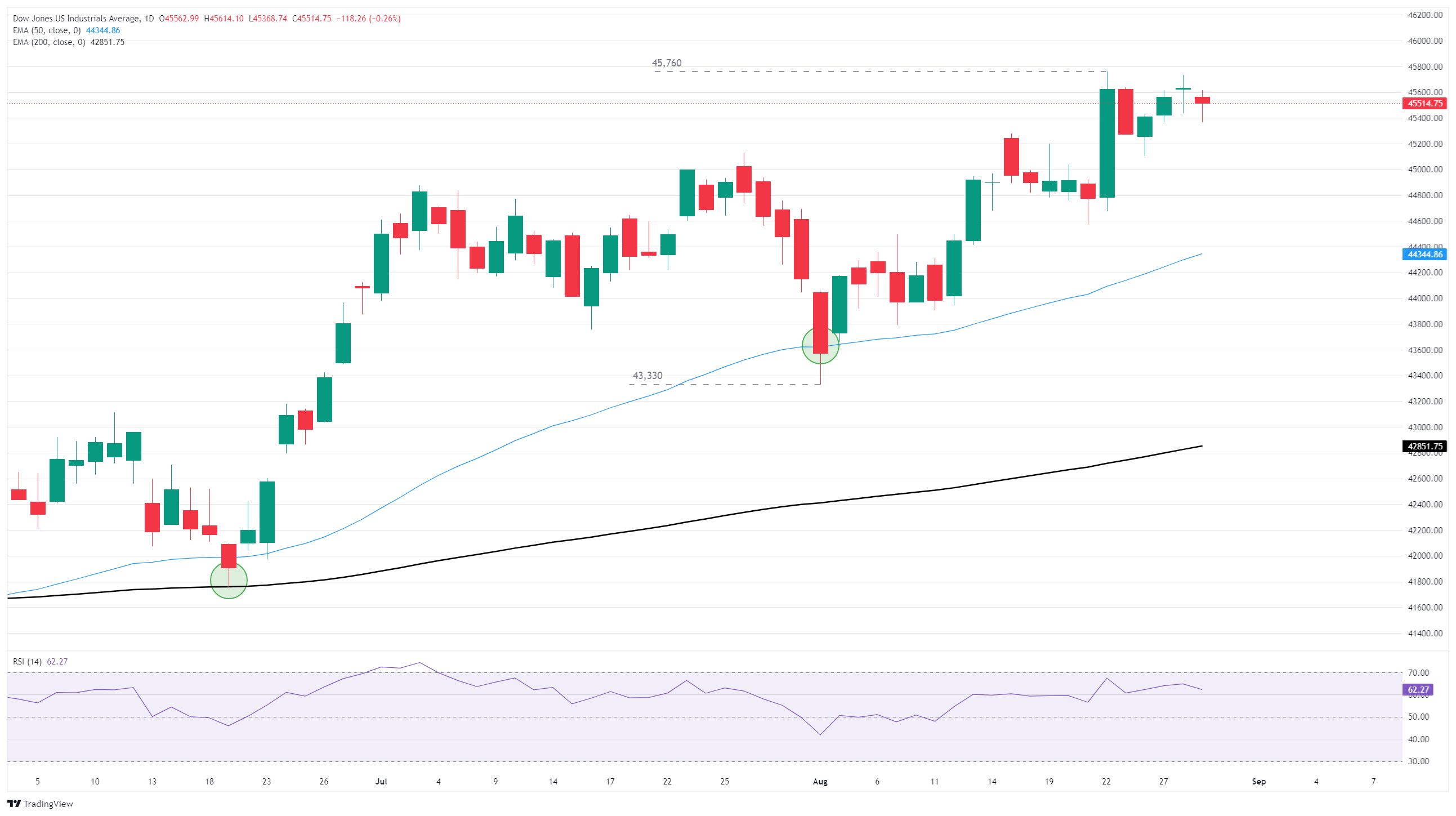Dow Jones Industrial Average stumbles after PCE inflation rises
- The Dow Jones eased lower on Friday, testing below 45,500.
- Equities recoiled after US PCE inflation metrics rose in-line with forecasts.
- Despite fresh inflation pressure, markets are still banking on a September rate cut.
The Dow Jones Industrial Average (DJIA) softened on Friday, easing back below 45,500 as stocks retreated due to another uptick in US Personal Consumption Expenditures Price Index (PCE) inflation figures. Despite rising inflation pressures, markets are still betting that the Federal Reserve (Fed) will deliver a fresh interest rate cut in September.
Equities falter post-PCE but only slightly
The Dow Jones is down, but certainly not out. The major equity index is still holding firmly onto near-term gains and remains within striking distance of all-time highs north of 45,760. Bullish momentum has dried up for the time being, but the Dow is still finding intraday support near the 45,500 region.
US core PCE inflation rose to 2.9% YoY in July, another step up in price pressure as tariff-led inflation effects continue to pull forward into main inflation metrics. July’s core PCE figure is the highest print since March of this year, functionally erasing five months of work on taming inflation.
Fed rate cut hopes remain elevated
Markets are still banking on an interest rate cut from the Fed on September 17. According to the CME’s FedWatch Tool, rate traders are still pricing in nearly 90% odds that the Federal Open Market Committee (FOMC) will deliver a quarter-point cut when it convenes next month.
Despite rising inflation pressure, the Fed may very well be arm-twisted into delivering interest rate cuts before achieving further momentum to their 2% inflation target. US employment figures took a sharp tumble through the second quarter, and a further backslide in hiring may force the Fed’s hand. The next round of key employment data will drop late next week.
Dow Jones daily chart

Dow Jones FAQs
The Dow Jones Industrial Average, one of the oldest stock market indices in the world, is compiled of the 30 most traded stocks in the US. The index is price-weighted rather than weighted by capitalization. It is calculated by summing the prices of the constituent stocks and dividing them by a factor, currently 0.152. The index was founded by Charles Dow, who also founded the Wall Street Journal. In later years it has been criticized for not being broadly representative enough because it only tracks 30 conglomerates, unlike broader indices such as the S&P 500.
Many different factors drive the Dow Jones Industrial Average (DJIA). The aggregate performance of the component companies revealed in quarterly company earnings reports is the main one. US and global macroeconomic data also contributes as it impacts on investor sentiment. The level of interest rates, set by the Federal Reserve (Fed), also influences the DJIA as it affects the cost of credit, on which many corporations are heavily reliant. Therefore, inflation can be a major driver as well as other metrics which impact the Fed decisions.
Dow Theory is a method for identifying the primary trend of the stock market developed by Charles Dow. A key step is to compare the direction of the Dow Jones Industrial Average (DJIA) and the Dow Jones Transportation Average (DJTA) and only follow trends where both are moving in the same direction. Volume is a confirmatory criteria. The theory uses elements of peak and trough analysis. Dow’s theory posits three trend phases: accumulation, when smart money starts buying or selling; public participation, when the wider public joins in; and distribution, when the smart money exits.
There are a number of ways to trade the DJIA. One is to use ETFs which allow investors to trade the DJIA as a single security, rather than having to buy shares in all 30 constituent companies. A leading example is the SPDR Dow Jones Industrial Average ETF (DIA). DJIA futures contracts enable traders to speculate on the future value of the index and Options provide the right, but not the obligation, to buy or sell the index at a predetermined price in the future. Mutual funds enable investors to buy a share of a diversified portfolio of DJIA stocks thus providing exposure to the overall index.

